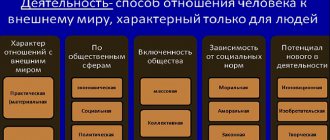Types of thinking and their characteristics: Unsplash Thinking is the most important ability of people. Thanks to him, a person learns about the world, gains experience, and plans for the future. Thinking arises as a result of practical and mental activity and comes in several types.
What types of thinking are there? Doctor of Psychological Sciences Robert Nemov divides thinking into theoretical and practical. In theoretical thinking, types such as conceptual and figurative thinking are distinguished, and in practical thinking, visual-figurative and visual-effective thinking are distinguished.
A few words about the concept
If we rely on the definition that Wikipedia gives us, then thinking is the mental process of modeling the laws of the surrounding world on the basis of axiomatic provisions.
The term has many simpler definitions.
Thinking is a human cognitive activity, the result of which is a thought in the form of an idea, meaning or concept.
In neuropsychology, thinking is considered one of the highest mental functions, which has a motive, a goal, a system of actions and control.
This phenomenon began to be studied back in ancient times. Philosophers and scientists considered it not from the point of view of psychology, but from the position of philosophy and logic. Many philosophers called thinking an essential property of man. This is clearly demonstrated by Descartes’ famous saying: “I think, therefore I exist.”
This process is related to the functioning of the brain. However, a person’s ability to think in one way or another arises in the process of life experience, culture, norms of language, logic and other factors.
The stages of development of thinking can be seen in the table.
Conceptual thinking
Having mastered practical types of thinking, a person learns to reason theoretically. At this stage, conceptual thinking appears.
What is characteristic of conceptual thinking? As N.I. Kozlov, Doctor of Psychological Sciences, notes, it is not innate and does not develop on its own; it is formed during training. At this stage the person:
- gets acquainted with concepts and remembers their properties without personal contact;
- establishes general patterns and forms logical classes;
- learns to build logical chains.
Conceptual thinking does not replace practical thinking, but only complements it. It is closely related to the use of speech and certain logical operators. Therefore, in various classifications it is called verbal-logical (verbal-logical) thinking.
Conceptual Thinking: Unsplash
Properties
A person perceives the surrounding reality based on his thinking. And everyone has their own. That is why we all look at the same things differently. But all people are united by certain properties of thinking. In psychology there are several of them:
- Focus. Every thought process has its ultimate goal.
- Logic. Contrary to popular jokes and anecdotes, women also have logic, but it is inextricably linked with feelings.
- Development. Only children at an unconscious age and people with mental disabilities have undeveloped thinking.
- The ability to form concepts. We can all characterize an object or phenomenon, compare it with similar ones, etc.
- Subjectivity. As we have already found out, everyone thinks differently. Objectivity is hampered by our feelings, experiences, mentality, etc. But it cannot be said that someone thinks correctly and someone does not. Everyone has their own truth.
- Linearity in time. Some focus their attention on the future, others reflect on the past. But everyone is trying to find a solution to the current situation.
I recommend that you familiarize yourself with a selection of books about thinking.
Theoretical imaginative thinking
What is the peculiarity of imaginative thinking? This type is different in that the “material” for thinking is not a visual object or concept, but an image. It comes from memory or is recreated by imagination. People of creative professions, in particular writers and screenwriters, most often resort to imaginative thinking. Psychologist N.I. Kozlov called this type scenario thinking.
People with strong imaginative thinking are said to have developed intuition. In fact, when they see a situation, they recreate possible turns of events from experience. Using logic and imagination, they can predict the development of even a situation unfamiliar to themselves.
Imaginative thinking: Unsplash
According to other classifications, in addition to the above types, there are also creative, analytical, intuitive thinking, pre-logical (the ability to compose the simplest logical chains), alternative (the ability to build several possible scenarios for the development of events and choose the best one), critical, strategic thinking, etc.
A person uses all types of thinking, but the greatest development is achieved by the one required by the type of activity. Find out what kind of thinking you do best, and it will likely become the basis of your profession.
Original article: https://www.nur.kz/family/school/1791961-vidy-myslenia-i-ih-harakteristika/
Forms
Thinking has three main forms:
- Concept. It is a thought that reflects the most significant, general and distinctive features of various objects and phenomena. A concept arises as a result of the cognitive activity of the brain, i.e. thinking.
- Judgment. This is a thought that contains an affirmation or denial of something about an object, its properties or connections between several objects. The consistent logical connection of several judgments helps us solve various problems and find answers to questions. This sequence is called reasoning.
- An inference is the result of a chain of judgments, that is, the very answer to the question that we are looking for when building our reasoning. Inference gives us new knowledge and understanding of objects and phenomena of the surrounding world. Inferences can be deductive, inductive or analogical.
What is thinking and its functions
Let's start, as always, with a definition.
Thinking is a process of processing information that reflects objective reality subjectively, through concepts, judgments, and conclusions. This is a higher process that is characteristic only of man, his cognitive activity.
Thanks to thinking, we develop, learn something new, and establish connections between objects. For example, we know that wine is a little intoxicating, a car can drive down a hill on its own, rain drums on the roofs, etc.
This higher process helps to understand the essence of the phenomenon: thunder thunders not because it wants to, but because a collision of discharges occurs. Or water boils not because it boils away, but because the temperature has risen. I got a little into physics here








